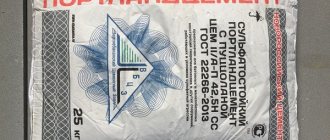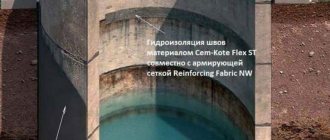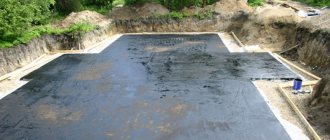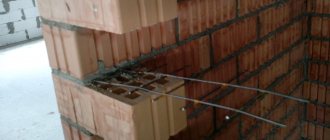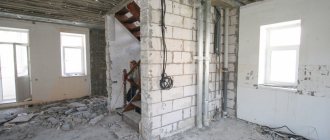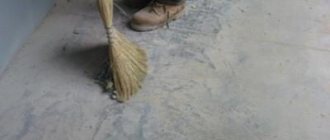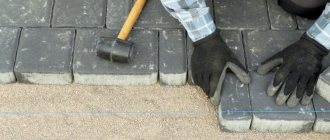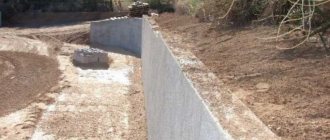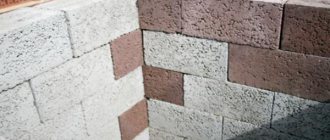Monolithic concreting is an important stage of work in the construction of load-bearing walls of buildings and the construction of foundations. These structures are most susceptible to damp air and require high-quality execution. However, when concreting walls using the cold joint method, there are many nuances.
What is a cold (working) seam?
When constructing buildings, structures and architectural complexes, the best concreting method is continuous pouring of concrete throughout the entire volume of the formwork. This is good if the building under construction is small. But, most often, in construction, floors, walls, and ceilings are concreted in layers. In order for a structure to be durable and strong, it must be concreted in a certain working rhythm; a pause in work should not exceed 5-7 hours. Each subsequent layer must be poured before the previous one has hardened. The boundary between concrete laid on an already hardened layer is called a cold joint. Violation of masonry standards negatively affects the technical characteristics of concrete.
Causes
The formation of concrete joints occurs under the influence of the following factors:
A joint may form if the mixture was not poured into the formwork in one go.
- Work organization. Construction is stopped due to a change in the work crew, breakdown and repair of equipment, lack of building materials, and the specific operation of the devices used.
- Features of the technology. The work is influenced by the chosen installation methods of formwork, floors, etc. Problems arise if it is necessary to reduce the pressure on the object.
- Design features. The reason is the need to direct deformations to a specific part of the reinforced concrete structure.
The formwork can be filled with mortar gradually. A new layer is applied to already hardened concrete, which reduces the adhesion of different levels. This design is less durable than monoliths without seams. Resistance to moisture and frost decreases, and the appearance of the structure deteriorates. This is explained by the fact that shrinkage compressive stress is converted between the boundary and the solution levels. As the mixture dries, it contracts. At this time, concrete is subject to negative external influences on tension and bending. A sharp weakening of tensile forces provokes the formation of small cracks. So the seam becomes less strong than the rest of the reinforced concrete structure.
In what cases when concreting walls is it necessary to do without a cold seam?
The working seam is a weak point in a building structure. However, if you follow all building codes and rules and do not violate masonry technology, then its properties will not affect the strength, integrity, or service life of the object. The peculiarity is that the quality of concrete pouring requires its homogeneity, in a situation where it is necessary to divide large structures into sectors of reverse action. Since a cold joint is a weak point in the construction of structures, it should be formed only in places that do not affect the strength of the structure. Joints are allowed to be made in objects taking into account their safety in the future. Since monolithic work on concreting walls is not always rational, cold concreting comes to the rescue. There may be several reasons:
- time-limited work shifts;
- technological break of machines and equipment;
- installation of reinforcement or scaffolding;
- pouring concrete for communications and parts;
- fragility of the surface with limited load;
- direction of deformation according to the load;
- alternately establishing a horizontal load, then a vertical one.
Urgent cold joints result from improper organization of work:
- prolonged breaks after the solution has hardened;
- insufficient amount of concrete for one-time filling;
- insufficient number of machines, equipment, scaffolding;
- outdated construction equipment;
- lack of necessary experience of engineering and technical personnel and workers;
- understaffing of construction teams.
Workplaces and the entire technological process should be organized before starting construction.
Ideal seam position
In the most preferred embodiment, the location of the seam exactly coincides with the position of zero (minimum) shear force in the monolithic structure. Such a place can be detected by performing specialized calculations (in the transverse force diagram). If calculations are carried out manually, then the place where the diagram intersects the horizontal is determined (the optimal place for the seam, since in this place the transverse force tends to zero). When calculating using specialized programs, the diagram of transverse forces or their color schemes are analyzed, which is more visual.
In drawings, the joint between layers of concrete is traditionally shown as a dotted line. For a more precise definition, the corresponding callout is used - “concreting working seam”. It is worth noting that changing the position of the seams is not allowed bypassing the diagrams made in the drawings, and compliance with the fairly clear recommendations outlined in SNiP 3.03.01-87 will allow you to obtain a strong and durable structure.
Disadvantages of cold seams
Joints formed as a result of violations of building regulations can lead to the formation of a high-risk zone in this place. If this happens to load-bearing walls, beams, floors, then their integrity is reduced. All quality characteristics are violated: frost resistance, wear resistance, strength, water resistance. The presence of water in microcracks oxidizes metal reinforcement, which rusts and leaves brown spots on the surface of beams and ceilings. The resulting cracks in concrete connections violate the solidity of the object, stretch and destroy it. It is not resistant to tension, so there is a threat to the entire building. It is very bad if there is moisture in concrete joints - it washes away the binding components and accelerates the destruction process. This poses a great danger to buried foundations, reservoirs, and hydraulic structures. If the connecting connections are made incorrectly, then with sudden changes in temperature, the physico-chemical state of the water will change. The process of alternate expansion and contraction of the material will lead to the destruction of the seam and the entire object.
Do you make cold joints when concreting walls?
Yes
No
Waterproofing dowels
This type of insulation consists of rubberized strips used for waterproofing and cold and expansion joints. At their core, waterstops are internal formwork, installed during concreting in places of greatest pressure on the concrete slab.
Advantages of waterstops:
The use of hydraulic gaskets in expansion and expansion joints allows the structure to withstand high loads and significant temperature fluctuations.
A wide selection of different types makes it possible to select a profile that meets both climatic and seismic conditions. And also keys can ensure the tightness of shrinkage joints with a large amplitude of vibration.
They are used mainly in the construction of new buildings, since installation in ready-made structures presents significant difficulties.
Disadvantages of waterstops:
With significant water flow pressure, the joining layer between the profile and concrete does not provide a 100% guarantee of impermeability.
Location of seams according to SNiP
A joint filled with concrete should not be a point of stress accumulation. It must be positioned strictly vertically relative to the axis of all concreting elements. They apply:
- in monolithic connections with large-sized beams (the seam is located below the surface of the slab at a distance of 20-30 mm);
- for beams whose seam is located at the level of the middle of the third part of the span;
- in columns where the cold seam is located at the bottom level of the purlins, top of the foundation, capitals;
- for flat slabs with a seam parallel to the smaller side of the monolith;
- for architectural structures with a seam specified in the design documentation.
It is permissible to concrete joints in horizontal and vertical planes.
Table of characteristics of concrete mixtures
| Class | Brand | Euro class | Mobility | Strength | Waterproof | Frost resistance | Rigidity |
| AT 10 | M150 | c8/10 | P2 - P4 | 163 kg/cm2 | W2 - W4 | F 50 | Zh1 – Zh4 |
| B15 | M200 | s12/15 | P2 - P4 | 196 kg/cm2 | W2 - W4 | F 100 | Zh1 – Zh4 |
| IN 20 | M250 | s16/20 | P2 - P4 | 275 kg/cm2 | W4 - W6 | F 150 | Zh1 – Zh4 |
| B22.5 | M300 | s18/22 | P2 - P4 | 296 kg/cm2 | W6 | F 200 | Zh2 - Zh4 |
| B25 | M350 | s20/25 | P2 - P4 | 337 kg/cm2 | W6 - W8 | F 200 | Zh2 - Zh4 |
| B30 | M400 | s25/30 | P3 - P5 | 392 kg/cm2 | W10 | F 300 | Zh3 - Zh4 |
| B35 | M450 | s30/37 | P3 - P5 | 458 kg/cm2 | W10 - W12 | F 200 - F300 | Zh3 - Zh4 |
| B40 | M550 | s32/40 | P3 - P5 | 524 kg/cm2 | W10 - W16 | F200 - F300 | Zh3 - Zh4 |
| B45 | M600 | s35/45 | P4 - P5 | 591 kg/cm2 | W12 - W18 | F200 - F400 | Zh3 - Zh4 |
Joint organization technology
When concreting cold joints, it is important to organize maximum adhesion of concrete blocks. The surface of the frozen stone is thoroughly cleaned of dirt, ice, water, and dust. In the process of cleaning concrete, it is necessary to remove the cement film formed by salts, sulfates, carbonates, nitrates, and chlorides that are in its composition. A loose film impairs adhesion between layers of hardened concrete mortar.
There are four methods for cleaning concrete surfaces:
- Mechanical restoration. Hand tools or automatic cutting of planes are used.
- Cleaning with a high-pressure jet of water or air.
- Hydrosandblasting.
- Cleaning by chemical oxidation.
Waterproofing seams prices, price and cost of 1 linear meter
| Name of works | Unit | Price in rubles |
| Waterproofing of cold joints: - Work on installing a groove - cleaning the groove - layer-by-layer compaction with a non-shrinking composition | m.pog | 600 |
| Waterproofing of interblock seams: - Work on installing a groove - cleaning the groove - layer-by-layer compaction with a non-shrinking composition | m.pog | 400 |
| Waterproofing of expansion joints: - Work on installing a groove - cleaning the groove - sealing an elastic profile - sealing a non-shrinking composition - a set of injection works | m.pog | 4900 |
| Waterproofing expansion joints using waterproofing TPO tape: A device for sealing the contour of an expansion joint using elastic tape with epoxy adhesive | m.pog | 990 |
| Injection waterproofing of seams / shut-off waterproofing - Work on installing a groove - cleaning the groove - layer-by-layer compaction of a non-shrinking composition - Work on constructing boreholes and installing packers - a set of injection works - dismantling packers and sealing injection holes | m.pog | 1200 |
| Cement-mineral waterproofing | m2 | 600 |
| Waterproofing of communication entry points: - Work on installing a groove - cleaning the groove - layer-by-layer compaction with a non-shrinking composition - Work on constructing boreholes and installing packers - a set of injection works - dismantling packers and sealing injection holes | PC | 6900 |
Cost calculator for waterproofing joints
Click to open the calculator and calculate the cost of work
Calculation of the cost of injection and suture waterproofing
Treatment after concreting
To prevent rupture of the sealed surface during the construction of the foundation, it is necessary to carry out all concreting work based on the technological characteristics of the cement solution and the recommendations of SNiP.
The next stage after treatment involves effective waterproofing, compaction and sealing of cold seams. There are two methods for performing the main types of working seams:
- Bookmark. Using slats, glass cuts and boards, filling sections are made. When the solution hardens, the auxiliary material is removed. The resulting voids are filled with sealant. This technology is convenient when laying floors.
- Cutting. The dividing device must have a grinding attachment or a diamond wheel. The grooves must be of the designated depth.
What kind of concrete (concrete mixture) is used to build swimming pools?
For the construction of swimming pool bowls, it is best to use high-grade heavy concrete with hydrophobic additives and plasticizers. NC cement is an excellent representative. Concretes, mortars based on NC and products made from them are completely waterproof, have increased corrosion resistance, and do not require additional waterproofing. Swimming pools built from concrete made from NC cement practically do not allow water to pass through and last for many years.
To obtain waterproof concrete, the mixture is mixed with crushed stone or gravel and mixed with the required amount of water. It is necessary to use only crushed stone or gravel of hard rocks and fractions of 10-30 mm. for the most part. When performing concrete work, reinforcement is mandatory.
Injecting cold joints with a mixture in case of poor-quality joints
The technology is simple. Drill injection holes with a diameter of 10-12 mm. At an angle of 45° from the face of the structure and place the holes evenly. They are drilled in such a way that they intersect a seam or crack in the middle of its depth. When injecting a cold seam, it is better to drill holes from the side that is more convenient. Their length should be no more than 45 cm - this is ⅔ of the thickness of the structure. The distance from the hole to the crack is 20 cm. To install the injectors, it is necessary to clean the channels from dirt and dust to their entire depth using pneumatic equipment or an industrial vacuum cleaner. Next, prepare a composition that will hermetically seal the fracture.
The seam must be treated with grinding equipment to remove debris that will interfere with good adhesion of the concrete. In this case, it is better to use sandblasting. To do this, you need to install it in a groove with a cross-section of 30x30 mm. It is necessary to seal the entire part along the length of the break or seam, approximately 5 cm wide. Then apply a compound that will seal the crack. The solution is poured 2-3 cm thick with a break of 1.5-2 hours. A thin layer of cement interacts more quickly with the hardened stone. There should not be a distance of more than one meter between gaps.
If the fault is more than 2 meters, it is necessary to provide for the possibility of rupture of the injection composition. To avoid this, it is better to use a fine-mesh reinforced mesh; it increases the strength of the structure being processed.
Basalt fiber
Basalt fiber (from roving) is intended for volumetric reinforcement of concrete, mortars and composite materials.
More details
To obtain class B30 concrete with a density of 2410 kg/m3, which is used for the construction of special structures (bank vaults, swimming pools), you will need high-strength Portland cement TsEM I 32.5N GOST 31108-2016 – TsEM I 42.5N GOST 31108-2016 (old designation M400–M500).
For a cubic meter of mixture, 470 kg of cement, 700 kg of medium fraction sand, 1000 kg of crushed granite and 165 liters of water are used. You will also need 1–2 liters of CemPlast additive and 1–3 kg of CEMMIX fiber.
Concrete has the following characteristics:
- mobility P3–P4;
- frost resistance F300;
- water resistance W10.
Compensatory
Expansion joints in concrete, as you can easily guess from their name, are designed to compensate for thermal expansion and other influences that can lead to cracks. They completely cut through the concrete structure (including reinforcement), essentially dividing it into several independent monoliths.
They are needed:
- With a monolithic structure length of over 50 meters.
It’s interesting: the legislator in the field of the maximum size of a monolith is the British Concrete Encyclopedia. However, in the British Isles the climate is much warmer than Russia, and, therefore, the maximum thermal expansion is lower. With this in mind, it makes much more sense to stick to at least half the size.
- Along the perimeter of the monolithic floor (the goal is to prevent shrinkage of the walls and foundation from causing cracking of its surface).
- Around columns resting on bedding or compacted soil.
The photo clearly shows the seam around the supporting element of the metal structure.
And in this case, of course, there are several rules.
- Thermal joints in concrete must have a width of at least 6 millimeters. The instructions are related to the thermal expansion of the material: with a smaller width, it may simply not be enough when heated.
- Around the columns, the seams surrounding them can be either square or round. The square one rotates 45 degrees relative to the column (so that it is straight opposite the corner of the column).
In the first two pictures the columns are insulated correctly. In the third, the column is not insulated from the screed. The price of a mistake is cracks in the monolith.
- The resulting cavities must be filled with sealant or some other insulating material. The accumulation of water, dirt and microorganisms will lead to accelerated destruction of concrete.

